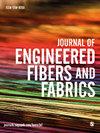提高农用纤维加固混凝土的强度:力学性能评估和微观结构分析
IF 2.2
4区 工程技术
Q1 MATERIALS SCIENCE, TEXTILES
引用次数: 0
摘要
混凝土在拉伸时很脆弱,会在毫无征兆的情况下发生脆性破坏。纤维是增加拉伸应变的最简单技术之一。有多种纤维(合成纤维)可供选择,如钢纤维、玻璃纤维和碳纤维。然而,这些纤维价格昂贵,不易获得。研究人员在混凝土中使用农用纤维代替合成纤维,以弥补这一不足。尽管一些研究表明,农业纤维可用于提高混凝土的抗拉强度。但是,我们需要一份详细的综述,综合所有相关信息,以便读者评估农用纤维的益处。因此,本综述重点关注农用纤维对混凝土坍落度、机械质量和耐久性影响的全面和最新概述。此外,还对扫描电子显微镜、增强方法和农用纤维增强混凝土(AFRC)的应用进行了综述。研究选取了五种不同类型的农用纤维,包括椰子纤维、黄麻纤维、香蕉纤维、稻草纤维和麻纤维。研究结果表明,农用纤维提高了混凝土的机械性能和耐久性,同时降低了坍落度。最佳剂量至关重要,因为剂量越大,机械性能越差。按粘结剂的重量/体积计算,最佳用量一般为 1%至 2%。在各种农用纤维中,椰子纤维的性能最好。与椰子纤维和黄麻纤维相比,对大麻、草木灰和香蕉纤维的研究较少。本文章由计算机程序翻译,如有差异,请以英文原文为准。
Improvement in the strength of concrete reinforced with agriculture fibers: Assessment on mechanical properties and microstructure analysis
Concrete is weak in tension, causing brittle failure without warning. Fiber is one of the simplest techniques to increase tensile strain. Several kinds of fibers (synthetic) are available such as steel fiber, glass fiber, and carbon fiber. However, these fibers are expensive and cannot be easily accessible. Researchers use agricultural fiber in concrete instead of synthetic fibers to offset this deficiency. Although, several studies have shown that agricultural fiber may be utilized to increase concrete tensile strength. However, a details review is required which combines all relevant information and the reader can evaluate the benefits of agricultural fiber. Therefore, this review focus on a comprehensive and up-to-date overview of the impact of agricultural fiber on concrete slump flow, mechanical quality, and durability. Furthermore, scanning electronic microscopy, enhancement methods, and agricultural fiber-reinforced concrete (AFRC) applications are also reviewed. Five different types of agricultural fiber including coconut, jute, banana, rice straw, and hemp fibers were selected. According to the findings, agricultural fiber increased concrete’s mechanical and durability qualities while comparably decreasing the slump. The optimum dose is essential as the higher dose adversely affects mechanical performance. The typical optimum amount varies from 1% to 2% by weight/volume of the binder. Among various types of agricultural fiber, coconut fiber is super performance. Less research is carried out on hemp, straw ash, and banana fibers than on coconut and jute fibers.
求助全文
通过发布文献求助,成功后即可免费获取论文全文。
去求助
来源期刊

Journal of Engineered Fibers and Fabrics
工程技术-材料科学:纺织
CiteScore
5.00
自引率
6.90%
发文量
41
审稿时长
4 months
期刊介绍:
Journal of Engineered Fibers and Fabrics is a peer-reviewed, open access journal which aims to facilitate the rapid and wide dissemination of research in the engineering of textiles, clothing and fiber based structures.
 求助内容:
求助内容: 应助结果提醒方式:
应助结果提醒方式:


